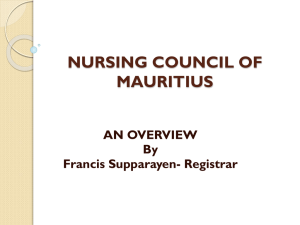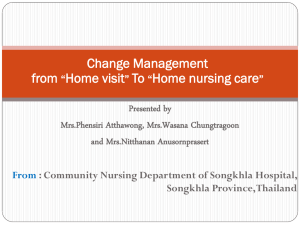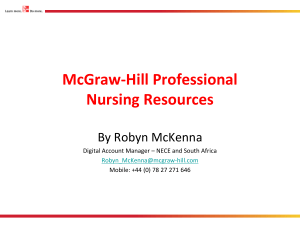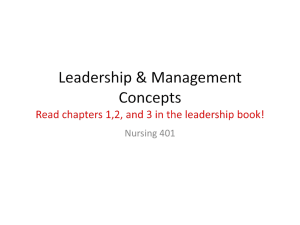PETERS-R_Day Services Nursing_PPT
advertisement
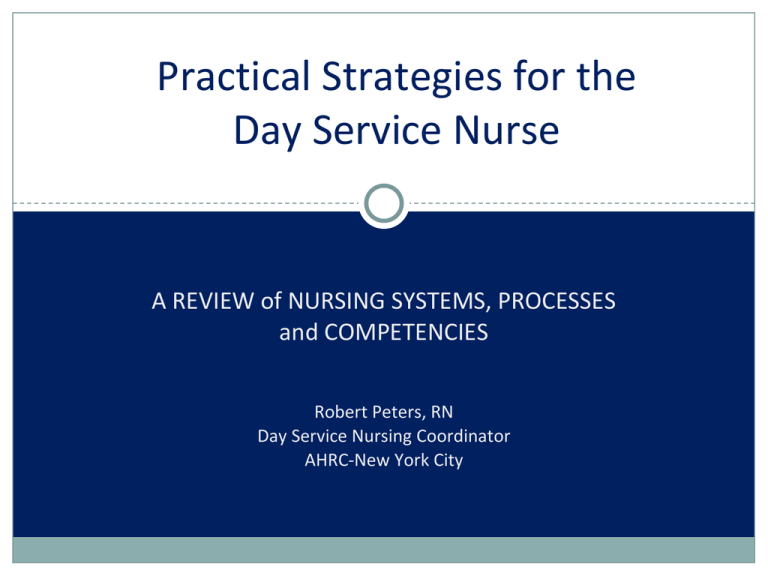
Practical Strategies for the Day Service Nurse A REVIEW of NURSING SYSTEMS, PROCESSES and COMPETENCIES Robert Peters, RN Day Service Nursing Coordinator AHRC-New York City History of IDD • Historically people with handicaps (physical, mental and intellectual conditions) occupied 'deviant' status • Object of dread, ridicule, evil/possessed person, sub-human, diseased. • Stigma remains to some degree, diseased organism treated with so-called "medical model" • “Historical ghosts” – fears, prenatal testing History of IDD • Europe 1800 Jean-Marc Itard met Victoire of Aveyron, the so-called "Wild Boy of Aveyron," and began what is regarded as the first documented case of special education. • United States in the 19th and 20th centuries, "feeblemindedness" and "mental deficiency“ • 1851, New York State Asylum established - eventually known as the Syracuse State School, then Syracuse Developmental Disabilities Services Office. • ‘Institutions,' 'schools,' or 'colonies,' originally called, operated a philosophy of treatment and training, relatively normal living conditions, educated residents, and provided opportunities for work on the grounds. History of IDD • Early 20th century, things get worse – dumping grounds • Philosophy of eugenics – “Social Darwinism” • Sterilization of IDD, especially women, strongly advocated by medicine and government • Germany, euthanasia became official medical policy sometime around 1920 • US, euthanasia practiced and advocated early 20th cent. • 1940’s American Psychiatric Association editorial endorsed legal euthanasia of mentally retarded children and the provision of psychotherapy to parents to relieve them of their guilt! History of IDD • 1930’s 1940’s depression, WWII, fiscal resources dried up, institutions had fewer staff who were less trained. AMAP. Beginning to get very crowded, but no children younger than five admitted • 1945 - Letchworth Village (130 buildings!) 20-30% overcrowded, 200 children sleeping in living rooms and on mattresses on the floors. • 1945 State Schools begin admitting children under five. • Late 40’s - as soon as the facilities at Willowbrook State School were available, limited numbers of infants could begin to be admitted • 1952 – Willowbrook opens, reaches 6000 individuals History of IDD • 1940’-1950’s: parent groups begin to form, dividing into community-based groups and institutional-based groups • First charitable organizations begin to form: NYSARC - 1949 UCP – 1949 Lifespire – 1951 YAI – 1957 Heartshare – 1970’s • Parents groups, parental initiative and parental power AHRC History 1948 some parents try to found “nursery school” Jan 1949, AHRC “founded” “It would seem that the pent up energies of many years propel us forward and we move with a motion and volition beyond our control." - Joseph T. Weingold, 1950 1953 nursery for preschoolers 1954, sheltered workshop 1957 day center, school, clinic and recreation 1959 OMRDD formed AHRC History 1970, group residence 1971, camp 1972, Geraldo 1970’s, de-institutionalization 1970’s, day treatment centers proliferate 1977 early intervention 1980’s, Medicaid waiver 1990, Americans with Disabilities Act AHRC History 1985, Sibling program 1986, “HIRE” - supported work project that involves job training and placement in competitive employment 1988, Bronx Seniors program 1995, community services TBI 2006, Director of Individualized Supports – person centered planning 2008 , College – Kingsborough Community, CSI 2009 , Without Walls – all 5 boroughs Today the agency: • Educational Services (early intervention through high school – autism) • Day Services • Camping & Recreation – weekends, trips etc. • Service Coordination - MSC • Employment & Business Services – supported job, jobs in the community • Residential Services, many types, includes skilled 24/h nursing, respite • In-Home Services • Family & Clinical Services – counseling, psych testing, OT/PT/speech • Department Individual Services & Supports – person centered planning • Legal - Guardianship and Advocacy • Sobriety Day services Day Treatment centers (in which abilities of the individual to function more independently and in the community are fostered) Vocational workshops (wherein structured work environments are offered for those who need them) Day Habilitation (a goals-oriented program involving recreation, education, culture, community exploration, voluntarism and work) – both site based and “Without Walls” Employment and Business Services – competitive and supported employment settings, spun off day service Managed care – do the same, or more, with less – remain hopefully optimistic Day services Larger centers: 228 people with 2 RN’s, 190 with 1 RN Small center: 50-80 people, RN covers 2 or more sites, on call very important Smaller center: colleges (non-certified) have about 20 students each, RN only assigned to review physicals, create protective oversight plans and do trainings Non-center: “Without Walls”, non-certified, 1 RN oversees Focus being IN THE COMMUNITY Nursing Regulations – Day Services • Nurse Practice Act – Art 139 of Education Law • ADM-2003-01 : Nursing Supervision of Unlicensed Direct Care Staff • Other OPWDD regulations, ADM, memos, alerts, guidelines • “Nursing in OPWDD” (67 pages), October 2012 – talks about frequency of visits, nursing ratio 1:50 or less, plans of nursing services (PONS), required orientation within 3 months of hire – RESIDENTIAL CENTRIC Nursing Regulations – Day Services How ADM-2003-01 is a CORE DOCUMENT for the day programs: • • • • • • • Applicability --- intention RN decides what can be delegated and to whom RN must supervise unlicensed staff in nursing delegation RN must be on call for supervision Nursing plans Staff trained on conditions Diabetes care, RN must have OPWDD training and annual update Nursing Regulations – Day Services • What does apply? • 624 regulations – Incident reports, abuse-neglect, Justice Center, medication errors, reports of death. • 633 regulations – rights, confidentiality, access to care, supervision responsibilities, staff training, first aid, CPR, emergencies, medical treatment, TB, meds-AMAP, OTC’s, other medication rules, DNR, HIV • 633: Self medication assessment, use the RES one or complete, done for people who live at home and take meds at program Nursing Regulations – Day Services • What does apply? • 635 regulations – finance, reimbursement, environment (building, life safety code) • “Dignity of Risk” – provide choices with reasonable and available options • What does apply? – annual physical exams (see handout), other medical, health and safety information • Challenge to know the current health status, assess risk and provide nursing oversight Nursing Regulations – Day Services So why even have nurses in the day programs? • Tradition – they were included based on the “school model” • Reality, it’s not just Band-Aids and “hand washing” • ADM 2003-01 makes it clear that they are required unless the program does not give meds, delegate any tasks, perform any nursing procedures, or require any specialized training – not real • More individuals with diverse health status in the community • Triage and chronic disease management • Saves money, if not for the agency paying salary, for families and society • Nurse is part of the continuum of care, for people living at home, the day program nurse may be key to the person’s health Day services – nursing plans • Day Hab Plan – includes safeguards necessary to provide for the person’s health and safety while participating in the habilitation service. • Protective Oversight Plans (aka the POP): • • • • • • • • • • Medical Alerts Allergies Special Diets Support for Safe Eating Adaptive Equipment Behaviors of Concern Supervision/support needs in the community/program Likes/Preferences AND Dislikes/what doesn’t work Fire Safety Transportation Safety (also notes “travel training”) Day services – nursing plans • Protective Oversight Plans (POP) are reviewed by all new staff, annually reviewed, must be reviewed immediately if there is a change in the POP • Staff training on the POP must be documented • Staff must know the POP for the people that they support and care for • A lot of responsibility for non-nurses, day program nurses must provide both good supervision of staff and encouragement to know their people and the person’s safety needs at all times • Staff can always go back and review and re-review the POP, annual trainings should reference who has what in the day program Day services – nursing plans • Enhanced Protective Oversight Plans (EPOP) – for special “behavior of concern,” “level of supervision required,” and/or “preventive/supportive strategies” • “Health Emergency Profile” (HEP) aka “nursing assessment” is part of the “Ready To Go” packet • Protocols (detailed care plans) will be attached to the POP if needed. • AND the POP will cite the Protocol (See attached protocol) if applicable Day services – Medical protocols What is a Protocol? DEFINITION: A protocol is a simple written plan authored by the supervising clinician, understood by staff, to follow the details of care in addressing the health or safety of an individual. It must contain the following 11 elements: 1. 2. 3. 4. 5. 6. 7. 8. 9. Name of the person Reason for the protocol Location, size, amount etc. as needed Procedures to be followed or done What to report to the clinician who authored it (problems) Name and signature of clinician Date protocol was written/annually reviewed Sources of Information used to write protocol (includes Rx) PROTOCOL REVIEW DOCUMENTATION for the author/clinician to re-affirm annually that the protocol is still in effect 10. An attached STAFF REVIEW form where staff document that they reviewed or were trained on the protocol 11. Other attachments as needed to fulfill the definition of a protocol (if needed) Day services – Medical protocols Individualized Medical PROTOCOLS: • • • • • • • • • Asthma protocol Bowel monitoring protocol Case management protocol* Catherization protocol Diabetes protocol Epipen protocol Helmet protocol Ostomy device protocol Restraints protocol Day services – Medical protocols Individualized Medical PROTOCOLS (Continued) • • • • • • Safe Eating protocol – Dysphagia Seizure protocol Skin Surface Check protocol Temporary or OTHER protocol Transfer protocol Urinary device protocol Day services – Medical protocols • Medical PROTOCOLS can either be completed by the RN based on MD orders or received “as a protocol” form the residence, MD, SLP, PT etc. • Day services uses standardized templates • Some templates adjust elements, for example the Seizure Protocol can include if the person has: • VNS magnet and how to use • Oral clonazepam after X amount of minutes • Diastat rectal gel after X amount of minutes • Variable time within to call 911 (the standard being 5 minutes) Day services – Medical protocols • Staff must be trained on the protocol • Only AMAP’s would be trained on medication specific protocols. • Anyone can be trained to use Epipen, must be explained • POP would say: • • • “Must see nurse or AMAP if….” or “Person must always have an AMAP when going on trips” or “PRN medications must always be taken out with the person” Day services – Medical protocols • Some protocols are designated NURSE ONLY, and might not be delegated • Catherizations, tube feedings or tube meds (even though permissible) • Some Diabetes Protocols (complexity, diabetes pumps) • Case management (done by the nurse only, appointments can be delegated) • While some protocols really should be delegated to non-nursing staff, emptying of urine and colostomy bags – toileting EPIPEN INDIVIDUAL: James Frost ALLERGIES: Bee stings and eggs LOCATION OF EPIPEN: In EPIPEN HOLDER located in the Nursing Office NOTE: the Epipen must go out into the community with staff, please sign it in and out for trips The EPIPEN should only be used if the person is experiencing an ANAPHYLACTIC REACTION. The signs and symptoms of an anaphylactic reaction are: Difficult or noisy breathing Swelling of lips, tongue, throat, face or eyes Feeling of apprehension, sweating, weakness or shock Weak and rapid pulse Dizziness, fainting, loss of consciousness Hives or welts on the skin Flushing of the skin Itching Anaphylaxis is an emergency situation. Treatment of anaphylaxis consists of: Administration of EPIPEN Calling 911 immediately Maintaining the ABC’s of CPR (airway, breathing, circulation) An incident report should be made after EMS arrives and cares for the individual Name of agent administered (EPIPEN) Dose administered Time of administration Site of administration Cause of anaphylaxis, if known Name of Nurse: Rob Peters, RN Signature/Title: Robert Peters, RN Date above protocol was written: 12/21/13 Sources of Information for above PROTOCOL: Rx from Dr. S. Adams, 12/18/13 SEIZURES VNS and Diastat INDIVIDUAL: Jason Hernandez You must always TIME a seizure (minutes and seconds), this is critical as it determines when and if 911 will be called or when and if emergency medication will be given. It is a 911 emergency for all people having seizures when: The person is having repeated seizures for 30 minutes or longer The person appears to be injured The persons color remains poor The person does not start breathing after the seizure has stopped (Start CPR) Prolonged confusion remains after the seizure (more than 10-15 minutes) The person is not responsive, does not regain consciousness, after the seizure The seizure looks very different from the person’s usual pattern (increase in number, longer lasting, changes in post-seizure behaviors not seen before in this person) Usual type of seizure: Other: Lenox Gastaut Syndrome, cluster seizures Seizure Protocol (include both VNS and Diastat), note Diastat requires a Nurse or AMAP: TIME THE SEIZURE At start of seizure activity, SWIPE VNS magnet over the VNS implant site (located between left armpit and collar bone) and hold there for 3 seconds (count: "one, one thousand", etc). Wait 20 seconds and repeat swipe again if necessary. If necessary, wait another 20 seconds and repeat again (total of 3 swipes if necessary) If seizures last > 5 minutes, or if cluster seizures repeat 3 or more times, nurse or AMAP should administer Diastat Rectal Gel as ordered. If seizures last > 5 minutes, or if cluster seizures repeat 3 or more times, nurse or AMAP should administer Diastat Rectal Gel as ordered. Magnet Location: Specify: In Jason's backpack and also in the nurses office in the drawer labeled "VNS magnets" Other Emergency Medication Used: NONE Name of Nurse: Sally Jenkins, RN Signature/Title: __________________________________________________ Date above protocol was written: 5/14/14 Sources of Information for above PROTOCOL: Rx Diastat 3/13/14, Rx VNS 2/3/11, still in effect Day services – Medical protocols • Protocols must be reviewed annually (in-service trainings) OR when new staff care for the person • Any changes to a protocol (based on an MD order) = that the POP might need to be revised, the protocol re-written and staff re-trained on the updated protocol • When one part changes all parts are set in motion Protocols and Protective Oversight Plans are a lot for staff to remember and can be a challenge to follow, support and encourage your staff in being the eyes, ears and hearts that we need them to be Nursing – Supporting DSPs • New hire agency (OSHA etc.) and department orientation • Agency trainings (AMAP, dysphagia, diabetes management, CPR, first aid) • Annual in-service trainings: • • • • • • Hot/cold weather Seizures Diabetes Skin injury checks Triage for the non-nurse (head injury, falls injury forms) And as needed: Diastat, Epipen, Glucagon, Ostomy care, VNS, Aging, Alzheimer's, psychotropic’s, flu and colds, nutritional concerns Day Services – Staff Support • AMAP supervision (pouring's with the RN present, in addition to re-cert) • Daily AMAP observations if AMAP’s give meds those days • Dysphagia supervision • Flu vaccine free to staff • Staff meeting updates • Nurse meeting with site supervisors (see Team Meetings for Nurses and Directors) • ISP meetings – attends with DSP as needed • Personal relationships, nursing advice Day Services – Staff Support Nurse must support DSP code of ethics: (see handout) 1. 2. 3. 4. 5. 6. 7. 8. 9. Person-centered support Promote physical and emotional well-being Integrity and responsibility Confidentiality Justice, fairness and equity Respect Relationships Self-determination Advocacy Day Services – Staff Support Nurse must support DSP core competencies for SUPPORTING GOOD HEALTH: (see handout) 1. 2. 3. 4. 5. 6. 7. 8. 9. Team work Teach/support positive behaviors Meal planning, food prep Knows medical, physical, psychological, dental needs Prevents illness & disease, teaches person Responds to S&S illness/injury and knows emergency procedures Safe clean environment Documents and protects health information Understands/implements good health practices Day service and residential nurses “Unity is plural and, at minimum, is two.” – Buckminster Fuller Day service and residential nurses NURSE: Shift Weekends Nights On Call Caseload/Ratio Case manages Really responsible? Wants to trade places? More satisfied? Residential 24/7 Yes Yes Yes Yes (50 max) Yes Yes No Yes Day Program M-F, 9-4 No No Yes, some No Sometimes No No Yes Review of Survey Monkey questionnaire, discussed at AHRC Nurses Meeting 9/19/14 Day service and residential nurses • Seeing each other as collaborators – taking care of the same person • Avoiding un-necessary CONFLICT • Shared challenges: new admissions more medically challenging, more challenging behaviors, more risk, more work loads • Nurses work in isolation, without peer support or other clinicians on a daily basis, dealing with emotional boundaries • Job description highly regimented-detailed, limited room for innovation, sharing and experimentation Strategies for supporting “shared individuals” • Collaboration between residential nurses and day program (all environments) is not a luxury but a necessity • Remain person centered • Go Zen and Pema! • Use the nursing process, discuss the area where clarity is needed, try to resolve on professional level, seek help as needed • Remember – we both nurses! Strategies for supporting “shared individuals” • Meet and communicate with “the other nurse” – bond as nurses, focus on the real problem • Regularly meet with other nurses at your agency, or at zone meetings, at trainings, professional organization (NYSNA) – reach out, network, ask to see what others do • Seek consultations from administrators, compliance, medical directors, nurse educators, other nursing peers, “human rights” committee, other “team” members • Is there any medical or nursing research that may assist resolution • “Take the initiative. Go to work, and above all co-operate and don't hold back on one another or try to gain at the expense of another.” – Buckminster Fuller Communication • Day Program communication challenges: • Intra site relationships (co-workers) • Intra agency relationships (other departments) • Inter agency relationships (outside agencies, DDSO) • Relationship with family • Relationship with guardian, CAB, other • Relationship with other care providers, clinicians • Relationship with the person Communication Work towards collaboration with residence, family etc. • Changing the culture of communication • Teamwork • Training together • Mutual respect Communication • • • • • Use an expected and known agenda Use a team meeting approach Share nursing decision making – collaborate nursing judgment Communication is key to advocacy and coordination of care “Don't fight forces, use them” – Buckminster Fuller Communication • • • • • • • • Improving Clinically focused RELATIONSHIPS Take pride in your practice Communicate effectively Embrace a team approach Speak up when you notice a problem or error Avoid negative behaviors Know the context Have a sense of humor Make the goal - UNDERSTANDING Case Study 1 – Bowel Monitoring Normal bowel function: • Normal frequency of bowel movements can range from 3 times a day to 3 times a week. • Doctors often define constipation as a stool (or bowel movement) frequency of less than 3 times a week. • Discomfort may be reported or observed as straining, hard stool, or feelings that client is unable to empty the bowel. • Normal stool in an adult or child (not infant) is brown, soft and formed. • White or clay-colored stool, black/tarry stool, bloody, thin ribbon-like stool, narrow/pencil-shaped stool, hard or liquid stool is usually considered abnormal. Case Study 1 – Bowel Monitoring • People with chronic constipation report they feel that they have a lower quality of life. • People who have only one or two bowel movements per week are more likely to have obesity, diabetes, diverticulosis, hemorrhoids, and colon cancer. • Constipation may lead to complications including fecal impaction, ulceration, bowel obstruction, sigmoid volvulus (the bowel twisting in a loop), incontinence of stool, rectal prolapse, urinary retention, possible dizziness (and falls). • Increasing intestinal distension (stretching of the intestines) may lead to loss of blood flow to the bowel, perforation, and tissue death. • Untreated, a bowel obstruction can cause hypovolemic or septic shock and death. Case Study 1 – Bowel Monitoring Factors that may contribute to constipation: • • • • • • • • Dietary factors - low residue (low fiber) diet, not drinking enough liquids Inactivity and immobility - movement disorders, gait disturbance (difficulty with walking and balance), wheelchair use, scoliosis, cerebral palsy, quadriplegia, paraplegia Environmental factors - lack of routine, lack of privacy, schedules that cause the client to ignore the urge to have a bowel movement (defecate) Structural abnormalities - hemorrhoids, tumors, narrow openings Smooth muscle or connective tissue disorders - amyloidosis, scleroderma Depression Neurological disorders such as stroke, Parkinson’s disease, spinal cord tumors Metabolic/endocrine disorders - high calcium, low potassium, low or high thyroid hormones (hypothyroidism or hyperthyroidism), diabetes, Addison’s disease Case Study 1 – Bowel Monitoring Factors that may contribute to constipation include many medications : Opioid analgesics – Morphine, codeine Non-steroidal anti-inflammatory drugs (NSAIDS) Antacids – Tums Anticholinergic drugs - Cogentin/benztropine, scopolamine (transdermal), atropine Antidepressants - particularly lithium and tricyclics Antipsychotics - Risperdal, Zyprexa, Haldol, Seroquel, Mellaril, Thorazine Antihypertensives - Captopril, Catapres/clonidine, Inderal/propranolol Antiarrhythmics - calcium channel blockers especially verapamil Diuretics - Diamox, Lasix, Hydrochlorothiazide Anticonvulsants - Klonopin, Neurontin, Lamictal, Dilantin/phenytoin, Topamax, Depakote, Antihistamines – Benadryl Antilipidemics - Lipitor Case Study 1 – Bowel Monitoring Maintaining Healthy Bowel Function: • Serve and eat foods high in fiber instead of refined carbohydrates and concentrated fats. Vegetables, fruits and cereals are high in fiber. Some foods can act as natural laxatives: figs, prunes, pears, raisins, and rhubarb. • Added intake of liquids should accompany an increase in fiber intake. Adults need at least 8 glasses of non-caffeinated beverages per day, unless a fluid restriction is required because of a medical condition. Fruit juices and warm liquids can be helpful. • Age-appropriate exercise program. Case Study 1 – Bowel Monitoring Maintaining Healthy Bowel Function: • Establish a routine for bowel movements that includes a regular time and privacy. A bowel movement is most likely to occur an hour after meals • Positioning is important while attempting a bowel movement. Squatting increases pressure on the rectum and encourages use of abdominal muscles. • Treatments used for constipation include bulk laxatives (psyllium or bran), stool softeners (Colace and Surfak), stimulants (bisacodyl or senna), osmotic laxatives (lactulose, milk of magnesia, sorbitol, sodium salts), lubricants (mineral oil), and enemas. • With bulk laxatives and stool softeners, enough liquids must be taken to make them work. Case Study 1 – Bowel Monitoring Monitoring bowel function: • It is important to have an established procedure for monitoring bowel function and responding to changes. • People should be asked on a daily basis whether they have had a bowel movement. • The information needs to be documented in order to learn what the individual’s normal routine is and to monitor for the development of problems. • Be sure to monitor the bowel function of clients who have had recent abdominal surgeries, injuries, medication changes, and changes in diet or activity level. • Since many clients are unable or unlikely to communicate verbally because of cognitive challenges, staff must also be skilled at detecting non-verbal signs of pain or discomfort. Case Study 1 – Bowel Monitoring SIGNS AND SYMPTOMS OF CONSTIPATION • Change in bowel frequency (decrease) or consistency • Soft, paste-like stool in rectum or hard stool with oozing liquid stool • Feeling of rectal fullness • Straining at stool • Decreased or hyperactive bowel sounds • Report of feeling abdominal fullness or pressure • Distended (swollen) abdomen • Indigestion • Severe gas • Nausea • Other - back pain, headache, decreased appetite Case Study 1 – Bowel Monitoring SIGNS AND SYMPTOMS OF A BOWEL OBSTRUCTION • Abdominal pain - may be described as dull, squeezing or ill-defined, constant, or "colicky" (a sharp pain that may come and go) • Abdominal distension - swollen abdomen may push on diaphragm and affect breathing • Nausea and vomiting • Decreased urine output (from dehydration which is possible even without vomiting) • Constipation • Fever, chills • Abnormal bowel sounds Case Study 1 – Bowel Monitoring How does day program balance the need of the individual’s safety with the need for privacy and autonomy What can be done for situations where the day programs feels that compliance would be impossible Is there technological solution Dysphagia • Impacts over 22% of the population over the age of 50- per ASHA- American Speech Language and Hearing Association • The aging and developmental disabled population often require the assistance of caregivers to assist with ensuring safe swallowing and diet orders are followed for multiple reasons including: • • • Maintaining adequate nutrition and hydration Providing the least restrictive diet to allow for maximum enjoyment at meals Promote independence and safety with eating and drinking Dysphagia Aging and Swallowing Issues As people age other factors can impact safe swallow function – dementia, Parkinson's, stroke Dental issues such as weakened or broken teeth can impact chewing Sensory changes as we age can impact how foods smell and taste decreasing appetite or desire to eat Osteoporosis can cause positioning issues of the head and neck that can make it difficulty for people to have the ideal posture for safe eating and drinking Muscle Fatigue and Atrophy can cause the muscles involved with swallowing to not be strong enough to execute a safe swallow as before Dysphagia • Willowbrook: The average feeding time for children who could not feed themselves was about three minutes. This was done by shoveling mashed up food into the children's mouths, leading to the most common form of death for children at Willowbrook, aspiration pneumonia. • People with IDD at risk for dysphagia (including weight loss and dehydration), choking and aspiration • OPWDD choking alerts, aspiration alert • ADM 2012-04: Choking Prevention Initiative • “Many people served by OPWDD have problems chewing and/or swallowing food, placing them at possible risk for choking or aspiration” – CPI manual Dysphagia also affects Meds Medication administration can also be impacted if a person has dysphagia. There can be specific orders on how to administer medication that may include: • • • • • • One pill at a time All pills crushed and in applesauce, pudding, or yogurt A combination of crushed pills and pills cut in half Medication should always be given with the person is sitting upright, not laying flat in bed Know which meds can be crushed, consult with MD Instruction/precaution on the MAR Dysphagia OPWDD timeline to get into compliance: • • • • • ADM 2012-04 dated 8/17/12 6 weeks to start new training, curriculum provided & standardized CPI-1 by 2/28/13 (online and for everybody) CPI-2 and completion of ADM elements by 8/30/13 (hands on training for “identified applicable parties” Identified applicable parties: - prepare food, assist with dining, feed or supervise individuals on a modified diet - supervisors of staff above Dysphagia Plan for ADM 2012-14 – agency wide initiative I. II. III. IV. V. VI. VII. TRAINING (included a “Bridge Training”) UPDATING OF ORDERS UPDATING OF FORMS UPDATING OF Nursing Policies UPDATING OF Other Policies UPDATING OF MATERIALS AT THE SITES IMMEDIATE PLAN Dysphagia Plan for ADM 2012-14 By late October: 10% 32% Currently Trained Require Bridge Not Trained 58% Dysphagia Plan for ADM 2012-14 The following dietary definitions no longer allowed by the ADM: 1. Chopped 2. Bite Size 3. Mechanical Soft Based on survey, day program has 226 individuals on modified food or fluids. Of these 226, 153 are on a chopped, bite size or mechanical soft diet and will require an update their “Dietary Orders” to conform to the ADM. Dysphagia Plan for ADM 2012-14 32% Requires New MD Order No Change 68% Dysphagia Plan for ADM 2012-14 The plan for these 153 individuals - nurses at the sites to send home a copy of the new Dietary Orders form with a cover sheet by agency medical director explaining the ADM and our requirement for updating the person’s orders. Cover letter dated November 1, 2012 with a deadline for completion of December 3, 2012. We anticipate delays in receiving updated orders and expect that some will continue to arrive after the deadline. Compliance will need to be discussed. Dysphagia Plan for ADM 2012-14 • As the updated MD orders are received for these 153 individuals, the nurse (or nutritionist supervised by the nurse) will do the following: • Review all existing feeding protocols. Those with Chopped, Bite Size, or Mechanical Soft diets (the old terms) will be manually corrected by the nurse or nutritionist based on the updated MD orders to conform to the ADM. Manual corrections will follow agency standards (single line strike through, print correction above, sign and date of person making the correction) • Update and correct the individuals Protective Oversight Plans with the new definitions. • Train staff on all updated diet orders, updated feeding protocols and updated POP. Dysphagia Plan for ADM 2012-14 • Updating of Dietary Orders Form • Updating of department and agency policies - When one part changes all parts are set in motion • Towards the end of July 2013, out of 153 people who needed updated dietary orders, only 4 were still pending. • One MD refused to change the order despite multiple communications, the agency medical director called him directly to resolve. On the INTRA-NET Dysphagia Staying in compliance with ADM 2012-04: • All new admission diet orders must comply with the ADM • Continued training of new staff: CPI-1 upon hire, the online course materials • As needed training of staff in CPI-2 • Use of Excel to track: a. Person b. Coordinator – nutritionist or nurse who oversees c. Modified Food, Fluids d. Protocol e. Supervision required (lunchtime life guard) f. Staff assigned, with back-ups Dysphagia Staying in compliance with ADM 2012-04: • The RN and nutritionist must review all new or updated DIET ORDERS and if a change to the Dysphagia & PICA list is needed they will DO THE FOLLOWING immediately upon receipt of the new order: • Email the nursing supervisor: Name of the individual, Type of food consistency, Type of fluid consistency, Whether an additional feeding or safe eating protocol is in effect (and attached to the POP), Level of staff supervision required, Names of the staff assigned to supervise or feed the individual after having confirmed with AHRC Staff Training that staff has passed 4 hour dysphagia training (CPI Part 2) and are listed in training records as having passed and are “up to date” Dysphagia Email the nursing supervisor immediately: • Verification that the POP has been updated with the new information • File the original feeding order into the chart, stamped DO NOT REMOVE • If necessary, review that the protocol is attached to the POP and staff trained IMPORTANT: nurses must support staff during mealtimes, offer encouragement and makes sure any problems are reported. Case Study 2 – Multiple Challenges What is the role of the family in Emily’s care Does their care meet the needs of the individual, of the program Is there a concern with multiple health care providers, who should be coordinating them when the family cannot Any concerns with using a DSP as a translator in this case Should APS be contacted Community health variables • • • • • • • • • Day program - “school nurse modeled” Health of individuals and health of the group Outbreaks: flu, chicken pox (varicella-shingles), head lice, pink eye, scabies, pneumonia, Molluscum contagiosum, strep, active TB Closing of programs (norovirus, food poisonings) Specialized cleaning or disinfecting requirements Transportation issues Informing other agencies, local health department, OPWDD Medical clearance requirements Challenge: trying to reduce ER visits Site based acuity levels • See the forest for the trees • Review of major risk factors (hand out) • Could add other factors: age, autistic, behaviors • Review given staffing (nursing, AMAP, other) • Make a nursing determination based on quantifiable • Determine: Low, moderate, high • What to do if everything is HIGH • What does an acuity level mean? Medical Clearance (see handout) • Focus upon health of the community – group, herd • RULE: Risk to themselves or others? Still symptomatic? RN decides • Supports at home to get the clearance, how likely • Customer service and lost billing/revenue • Relationship with family/residence (problem of keeping someone at home) • Usually: FLU, other contagions, N/V/D, hospitalization, change in ADLs Thank-you Special thanks to my nursing colleagues at AHRC Iris Finkelstein, RN and Marcia Richman, RN Bibliography ANA. Intellectual& Developmental Disabilities Nursing: Scope and Standards of Practice. 2nd Edition. ISBN: 9781558104662, Silver Spring, MD., 2013 Cotter, Sarah MS,CCC-SLP, Director of Therapy , Select Rehabilitation. Eating Should Not Be Life Threatening: Oral Care, Diet, and Safe Swallowing, Spring 2014 Goode, David. Now Let’s Build a Better World: The story of the Association for the Help of Retarded Children, 1948-1998. New York, NY, December 1998 Larson, Jennifer. Seven Secrets to Improving Nurse–Physician Relationships. NurseZone.com. July 9, 2014 Multiple authors, Center of Creative Leadership. Adapting to Organizational Change. ISBN: 9781604911824, Greensboro, NC., 2013 Nehring, Wendy M. ed. Core Curriculum for Specializing in Intellectual and Developmental Disability: A Resource for Nurses and Other Health Care Professional. ISBN: 0763747653, Boston, MA., 2005 OMRDD, NY State, Administrative Memo 2003-01, Registered Nursing Supervision of Unlicensed Direct Care Staff in Residential Facilities Certified by the Office of Mental Retardation and Developmental Disabilities. January, 2013 Wetzel, Frederick PhD. Regulations and Requirements for Health and Nursing Services in Day Services. Inter Agency Council. New York, Spring 2014 Wolfe, Linda C., Selekman, Janice. School Nurses: What It Was and What It Is. Pediatric Nursing Journal 2002; 28(4)





